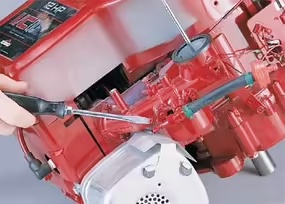
Servicing Battery Ignition Systems
A battery is a device containing electrical cells that produce and store direct current. Batteries used to start and operate small engines typically store 6 volts or 12 volts. Here’s how to service a battery ignition system:
Servicing Mechanical-Breaker Ignitions
For many years, mechanical-breaker ignition systems were the most popular of all ignition systems. The high voltage electricity from the coil is turned on and off using contact points and a condenser. The spark must be correctly timed to reach the spark plug at the exact moment when the piston is at the top of its travel and the fuel-air mixture is fully compressed. Here’s how to service a mechanical-breaker ignition:
Servicing Capacitor-Discharge Ignitions
Capacitor-discharge ignitions (CDIs) store and deliver voltage to the coil by way of magnets, diodes, and a capacitor. The mechanical points of a breaker point ignition are replaced with electronics. The only moving parts are the magnets on the flywheel. That’s why this system is sometimes called a breakerless ignition.
Because there are no breaker points on this system, there is no requirement for timing. However, the trigger module performs the same function as points. There must be a specific gap between the trigger module and the flywheel projection. Refer to your owner’s or service manual for specific steps to setting this gap.
Servicing Transistor-Controlled Ignitions
A transistor-controlled ignition (TCI) uses transistors, resistors, and diodes to control the timing of the spark to the engine. Because it has no moving parts, it too is called a breakerless or solid-state ignition. Most TCIs require no service. However, to ensure long-term performance, perform the following inspection on a regular basis.
The TCI controls a voltage of up to 30,000 volts for delivery to the spark plug. Be extremely careful when working around the TCI, as you can injure yourself or the ignition system with high voltage.
Servicing Flywheels
The flywheel on a small gas engine is a simple part that requires little service. The most important part of servicing a flywheel is to inspect it for damage periodically.
Mixing Fuel-Oil for Two-Stroke Engines
Two-stroke engines are efficient. They only require a single rotation of the crankshaft to develop power. This simplicity requires economy in all engine systems, including lubrication. A two-stroke engine is lubricated by mixing oil with the gasoline. This fuel-oil mixture can be purchased as such, or you can mix it yourself.